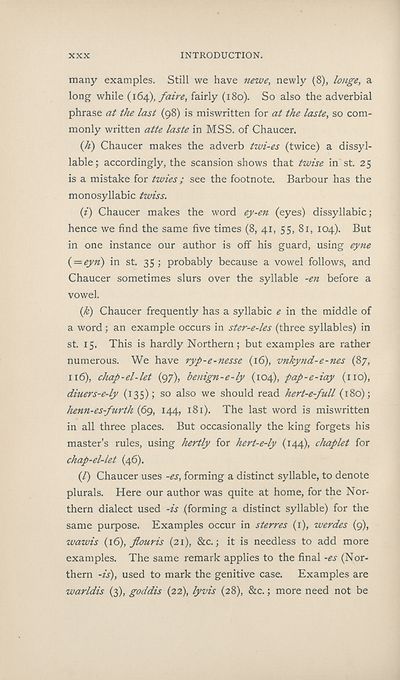Scottish Text Society publications > New series > Kingis quair; together with A ballad of good counsel
(40)
Download files
Complete book:
Individual page:
Thumbnail gallery: Grid view | List view

XXX
INTRODUCTION.
many examples. Still we have newe, newly (8), longe, a
long while (164), faire, fairly (180). So also the adverbial
phrase at the last (98) is miswritten for at the laste, so com¬
monly written atte laste in MSS. of Chaucer.
{h) Chaucer makes the adverb twi-es (twice) a dissyl¬
lable; accordingly, the scansion shows that twise in st. 25
is a mistake for twies; see the footnote. Barbour has the
monosyllabic twiss.
(i) Chaucer makes the word ey-en (eyes) dissyllabic;
hence we find the same five times (8, 41, 55, 81, 104). But
in one instance our author is off his guard, using eyne
{ = eyn) in st. 35; probably because a vowel follows, and
Chaucer sometimes slurs over the syllable -en before a
vowel.
(k) Chaucer frequently has a syllabic e in the middle of
a word; an example occurs in ster-e-les (three syllables) in
st. 15. This is hardly Northern; but examples are rather
numerous. We have ryp-e-nesse (16), vnkynd-e-nes (87,
116), chap-el-let (97), benign-e-ly (104), pap-e-iay (no),
diuers-e-ly (135); so also we should read hert-e-full (180);
henn-es-furth (69, 144, 181). The last word is miswritten
in all three places. But occasionally the king forgets his
master’s rules, using hertly for hert-e-ly (144), chaplet for
chap-el-let (46).
(/) Chaucer uses -es, forming a distinct syllable, to denote
plurals. Here our author was quite at home, for the Nor¬
thern dialect used -is (forming a distinct syllable) for the
same purpose. Examples occur in sterres (1), werdes (9),
wawis {\6), flour is (21), &c.; it is needless to add more
examples. The same remark applies to the final -es (Nor¬
thern -is), used to mark the genitive case. Examples are
warldis (3), goddis (22), lyvis (28), &c.; more need not be
INTRODUCTION.
many examples. Still we have newe, newly (8), longe, a
long while (164), faire, fairly (180). So also the adverbial
phrase at the last (98) is miswritten for at the laste, so com¬
monly written atte laste in MSS. of Chaucer.
{h) Chaucer makes the adverb twi-es (twice) a dissyl¬
lable; accordingly, the scansion shows that twise in st. 25
is a mistake for twies; see the footnote. Barbour has the
monosyllabic twiss.
(i) Chaucer makes the word ey-en (eyes) dissyllabic;
hence we find the same five times (8, 41, 55, 81, 104). But
in one instance our author is off his guard, using eyne
{ = eyn) in st. 35; probably because a vowel follows, and
Chaucer sometimes slurs over the syllable -en before a
vowel.
(k) Chaucer frequently has a syllabic e in the middle of
a word; an example occurs in ster-e-les (three syllables) in
st. 15. This is hardly Northern; but examples are rather
numerous. We have ryp-e-nesse (16), vnkynd-e-nes (87,
116), chap-el-let (97), benign-e-ly (104), pap-e-iay (no),
diuers-e-ly (135); so also we should read hert-e-full (180);
henn-es-furth (69, 144, 181). The last word is miswritten
in all three places. But occasionally the king forgets his
master’s rules, using hertly for hert-e-ly (144), chaplet for
chap-el-let (46).
(/) Chaucer uses -es, forming a distinct syllable, to denote
plurals. Here our author was quite at home, for the Nor¬
thern dialect used -is (forming a distinct syllable) for the
same purpose. Examples occur in sterres (1), werdes (9),
wawis {\6), flour is (21), &c.; it is needless to add more
examples. The same remark applies to the final -es (Nor¬
thern -is), used to mark the genitive case. Examples are
warldis (3), goddis (22), lyvis (28), &c.; more need not be
Set display mode to: Large image | Zoom image | Transcription
Images and transcriptions on this page, including medium image downloads, may be used under the Creative Commons Attribution 4.0 International Licence unless otherwise stated. ![]()
| Publications by Scottish clubs > Scottish Text Society publications > New series > Kingis quair; together with A ballad of good counsel > (40) |
|---|
| Permanent URL | https://digital.nls.uk/113908775 |
|---|
| Description | A collection of over 100 Scottish texts dating from around 1400 to 1700. Most titles are in Scots, and include editions of poetry, drama, and prose by major Scottish writers such as John Barbour, William Dunbar, Gavin Douglas, and George Buchanan. Edited by a key scholarly publisher of Scotland's literary history, and published from the late 19th century onwards by the Scottish Text Society. Available here are STS series 1-3. |
|---|

